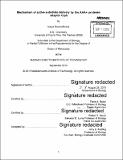Mechanism of active substrate delivery by the AAA+ protease adaptor CIpS
Author(s)
Rivera-Rivera, Izarys
DownloadFull printable version (8.618Mb)
Other Contributors
Massachusetts Institute of Technology. Department of Biology.
Advisor
Tania A. Baker and Robert T. Sauer.
Terms of use
Metadata
Show full item recordAbstract
AAA+ molecular machines power myriad cellular processes including protein degradation, microtubule severing, membrane fusion, and initiation of DNA replication. Protein quality control in all organisms involves deployment of ATP-dependent proteases, consisting of hexameric AAA+ rings that unfold and translocate specific substrates into an associated peptidase barrel. Adaptor proteins assist in recognition and degradation of certain substrates, but how enzyme-adaptor pairs ensure proper substrate selection is incompletely understood. In this thesis I focus on the delivery mechanism employed by the bacterial adaptor protein CIpS. The CIpS adaptor collaborates with the AAA+ CIpAP protease to recognize and degrade N-end rule substrates. CIpS binds the substrate's N-degron and assembles into a high-affinity CIpS-substrate-CIpA complex, but how the N-degron is transferred from CIpS to the axial pore of the AAA+ CIpA unfoldase to initiate degradation is not known. Here, we demonstrate that the unstructured N-terminal extension (NTE) of CIpS enters the CIpA processing pore in the active ternary complex and that CIpA engagement of the CIpS NTE is crucial for CIpS-mediated substrate delivery. In addition, I report evidence that CIpA engagement of the CIpS NTE drives structural rearrangements in CIpS important for N-end rule substrate delivery. Furthermore, our preliminary experiments suggest that CIpS is able to resist degradation by CIpAP due to a combination of a high local stability and a challenging translocation sequence at the junction of the NTE and folded core domain. I propose a model in which CIpA remodels CIpS by translocating the NTE, triggering delivery of the N-end rule substrate. Similar mechanisms may be employed by other AAA+ enzymes that collaborate with adaptor proteins to remodel/disassemble substrates without destroying them by degradation.
Description
Thesis: Ph. D., Massachusetts Institute of Technology, Department of Biology, 2015. Cataloged from PDF version of thesis. Includes bibliographical references.
Date issued
2015Department
Massachusetts Institute of Technology. Department of BiologyPublisher
Massachusetts Institute of Technology
Keywords
Biology.